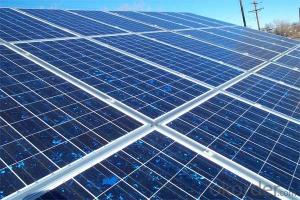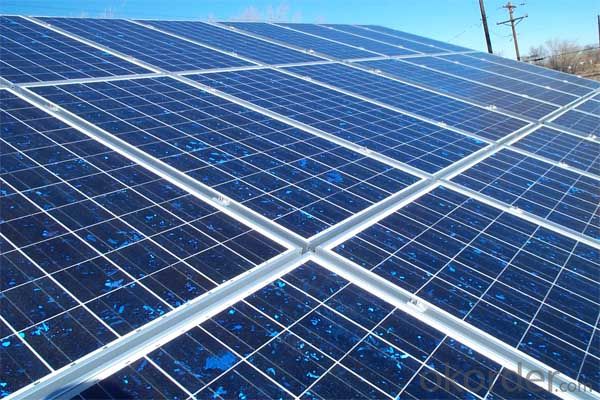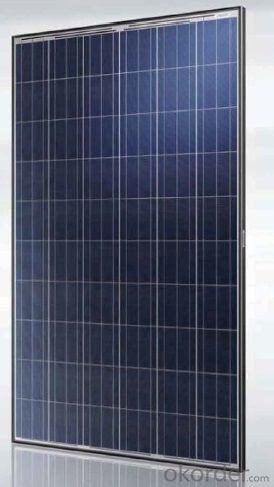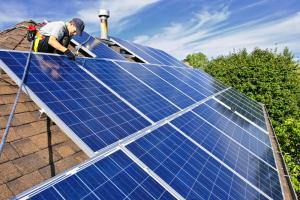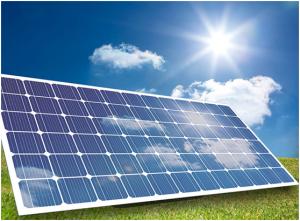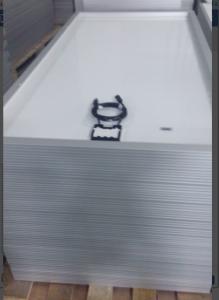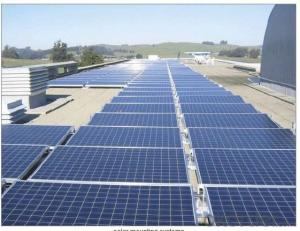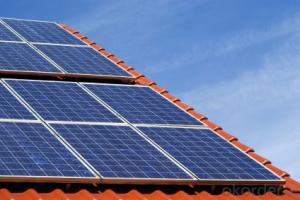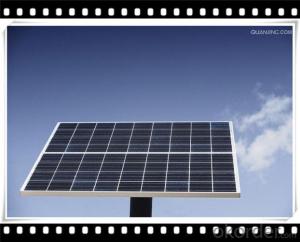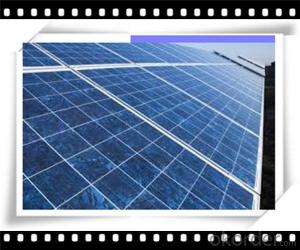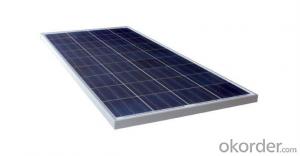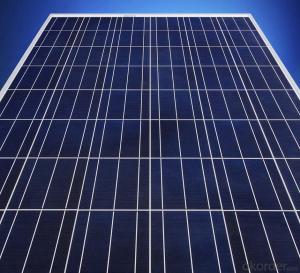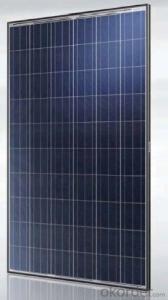50W Shade Stopper Poly Solar Panel - Home Small Solar Panel CNBM
- Loading Port:
- Qingdao
- Payment Terms:
- TT OR LC
- Min Order Qty:
- 10 set
- Supply Capability:
- 300000 set/month
OKorder Service Pledge
OKorder Financial Service
You Might Also Like
Polycrystalline Solar Modules
CNBM offers a range of small, medium and large polycrystalline solar modules, designed for a range of requirements.
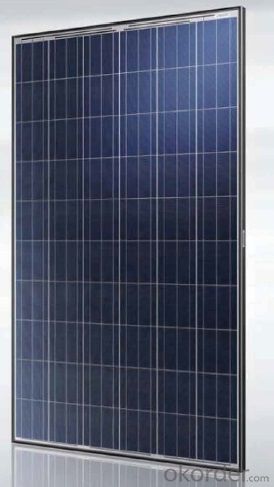
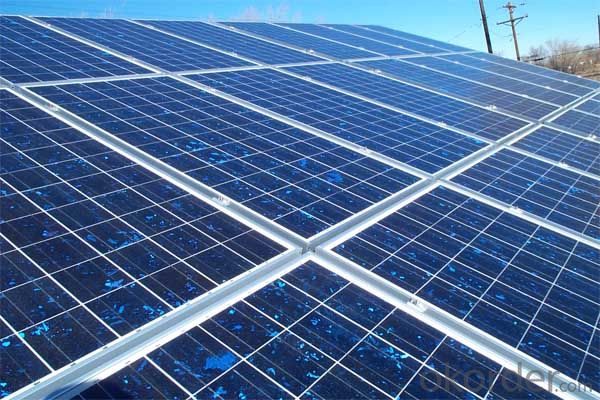
Specifications:
Tolerance | +/-3% |
Cell | Polycrystalline silicon solar cells (156 x 156mm) |
N0. of Cells | 60 (10 x 6) |
Dimension of Modules (mm) | 1650 x 990 x 40 |
Weight (kg) | 25.5 |
Limits:
Operating Temperature | -40~+85? |
Storage Temperature | -40~+85? |
Maximum System Voltage | 1000 VDC max. |
Hail Impact | Diameter of 28mm with impact speed |
Temperature and Coefficients:
NOCT | 48C+/-2? |
Voltage temperature coefficient (%/K) | -0.35 |
Current temperature coefficient (%/K) | 0.05 |
Power temperature coefficient (%/K) | -0.45 |
Characteristics:
Model: | SGM-200P | SGM-210P | SGM-220P |
Max-power voltage Vmp (V) | 29.2 | 29.4 | 29.41 |
Max-power current Imp (A) | 6.85 | 7.14 | 7.48 |
Open-circuit voltage Voc (V) | 36.5 | 36.69 | 36.9 |
Short-Circuit Current Isc (A) | 7.28 | 7.6 | 7.93 |
Max-power Pm(W) | 200 | 210 | 220 |
Model: | SGM-230P |
Max-power voltage Vmp (V) | 29.8 |
Max-power current Imp (A) | 7.72 |
Open-circuit voltage Voc (V) | 37.31 |
Short-Circuit Current Isc (A) | 8.19 |
Max-power Pm(W) | 230 |
STC: Irradiance 1000W/m2, module temperature 25?, AM-=1.5
Poly Crystalline Solar Panels Specifications Range
Maximum Power (Pm) | Dimension | Weight | Operating Voltage (Vmp) | Operating Current (Imp) | Open Circuit Voltage (Voc) | Short Circuit Current (Isc) |
0.45W | 140x80x10mm | 0.08kg | 3.3V | 150mA | 4.6V | 160mA |
1.0W | 162x140x10mm | 0.16kg | 7.5V | 150mA | 10.3V | 160mA |
4.5W | 269x251x23mm | 0.8kg | 16.5V | 0.27A | 20.5V | 0.3A |
10W | 420.1×268.9×22.6mm | 1.92kg | 17.5V | 0.58A | 20.5V | 0.6A |
20W | 425x502x50mm | 3.0kg | 16.8V | 1.19A | 21.0V | 1.29A |
30W | 593x502x22.6mm | 3.9kg | 16.8V | 1.78A | 21.0V | 1.94A |
40W | 655x537x50mm | 5.75kg | 17.3V | 2.31A | 22.1V | 2.54A |
50W | 839x537x50mm | 6.0kg | 17.5V | 2.9A | 21.8V | 3.17A |
65W | 1111x502x50mm | 7.2kg | 17.6V | 3.69A | 22.1V | 3.99A |
80W | 1204x537x50mm | 7.7kg | 17.6V | 4.55A | 22.1V | 4.8A |
- Q: Can solar panels be installed in areas with heavy snowfall?
- Yes, solar panels can be installed in areas with heavy snowfall. However, it is important to consider certain factors such as the angle of the panels, their orientation, and regular maintenance. Proper installation and tilt angles can help reduce snow buildup, and occasionally clearing the snow off the panels may be necessary to ensure optimal energy production. Additionally, advancements in solar technology have made panels more resilient and efficient in colder climates, allowing them to generate electricity even in snowy conditions.
- Q: I was hearing that we need silver as a medal for the creation of solar panels, is this true? How much silver would be needed to make one solar panel? (if this is true)
- Some research has shown that small amounts of silver can improve the efficiency of solar panels. But this appears to be in the research stage and applies to the the thin film solar cells. Some solar panels makes use silver as the wiring in kind of a screen printing process, but you don't need to use silver, you can use copper or aluminum using different techniques instead. Generally the metal used is in small amounts and not a majority of the cost of the solar panel.
- Q: Can solar panels be installed in areas with high pollution levels?
- Yes, solar panels can be installed in areas with high pollution levels. While pollution can reduce the efficiency of solar panels to some extent by blocking sunlight, they can still generate electricity even under such conditions. Regular maintenance and cleaning can help mitigate the impact of pollution on the performance of solar panels, making them a viable option even in areas with high pollution levels. Additionally, installing solar panels can help combat pollution by promoting the use of clean, renewable energy sources.
- Q: how much energy does solar panels save you? (like a month, year, etc)
- It depends on the size of the solar panels and the intensity of the solar-light. So, there's difference in every place. It's impossible to answer unless there's detail of panel size, panel quantities, average rainfall, average solar days, etc.
- Q: I don't want to spend a fortune, maybe talking like over $200 but I would like to power my computer, the monitor, my tv, and a small fridge.I looked up the price on some but it does not make any sense to me because it says that it has reached the price of less than $ per watt but if I look up a 20 watt solar panel it is $560 dollars. Why would it not be $20 because they said $ a watt.Where would be the best place to buy the cheapest solar panels?
- The cost of solar panel depends on per Watt..typically per watt cost is around USD 4-5, so if you take 75W solar panel it will cost around USD 300-375. I hope this helps
- Q: I have this question for extracredit and I dont get it?How many 2V,2W PV panels would be required to supply a load that requires a 48-volt supply that can push at least 2.8 amps of current, if you assume each panel puts out A at 2 V? And how are the panels configured to supply the power requirements of the load?
- 4 in series for the 48V, a rack of 3 sets wired in parallel to give the current. (total of 2 panels)
- Q: With no moving parts, no fuel piping and so on...
- It's all in the production process that uses materials and processes that are not yet cheap because of the little infrastructure in this field. You can make cheaper solar panels, but it restricts their efficiency, so you get less energy. The reason individuals haven't been catching on to it is because it is not yet entirely cost effective. For a normal 3-person home to be powered completely by solar, depending on many conditions, especially where you live, the payback period is something over 50 years. I live in Boston and for my house to be powered by solar I wouldn't see it making money for over 75 years! What people have to realize is that the point of solar is not to completely power your house cheaply, but to lessen the strain on the electrical grid, and if enough people do this the cost will certainly come down. That and the technology of solar panels has been developing unbelievably fast with all of the green energy buzz going around, so you should see the cost dropping in the next few years as new discoveries are made.
- Q: How do you know when it is a good deal to buy a solar panel. For example, what is a good cost per watt, how many volts should I expect, etc.
- first okorder / example: house roof is 20' x 20' 20' = 240, so sq. inches of roof is = 57,600 say rain fall for your area is 3 per month on average. 57,600 x 3 = 72,800 of rain collected. Using the conversion chart link above, that many cubic inches of water = 750 gallons of water free per month. Look at your water bill and see how much you use. Solar panels take on average 2-20 yrs to pay themselves off, just in time for them to be replaced. Paddle wheels go on for just about forever. We still find large paddle wheel mills in the USA that are over 200 yrs old, and still functioning.
- Q: Can anyone give me some info on how to figure how many panels needed for a 0 volt 2 amp pool motor. Thanks/ Run 5 hours a day
- You okorder /
- Q: I have an off-grid 24volt existing system using 8 x 80 watt 2volt, wired at 24volts, mono solar panels with deep cycle batteries,operating now. I have been given a 240 2volt polly cryst. panel. Can I add this panel to existing panels as above. Thank you, dumb solar man
- Assuming that you have / will upgrade wiring sizes to carry the extra wattage, that the new total wattage resulting from the addition doesn't overload any existing charge controller, diodes and / or inverter you have installed, then paralleling it straight into one of the other 2 volt groups should do nothing but add current to the system. True, it will be somewhat imbalanced, but it will work. Your other options would be to reconfigure everything down to it's native 2 V configuration which will raise current and lower voltage, with the additional panel creating the additional current to raise the wattage or to put it in series with the other 4 panel clusters so that you would get 36 V and additional current to account for the raised wattage. One last approach might be to set it up on another battery bank of it's own (small and at 2 V) to then connect to the same inverter. You'd be getting more power and storage capability that way, sort of a partial backup system, really, that will take some of the load off the other components to help extend their useful lives and get a bit more flexibility into it as well. The choice is yours here. That is all the ways that the system can be connected in, assuming everything in the first sentence checks out;-) It's difficult to make a recommendation without knowing what other components are in use and what the maximum ratings they carry are. Just remember that parallel connections add current and voltage stays the same, series connections add voltage and the current remains the same and you can figure out what to do with this thing to help you if you stay within maximum ratings for the charge controller, diodes and / or inverter involved. Good luck and stay safe!
Send your message to us
50W Shade Stopper Poly Solar Panel - Home Small Solar Panel CNBM
- Loading Port:
- Qingdao
- Payment Terms:
- TT OR LC
- Min Order Qty:
- 10 set
- Supply Capability:
- 300000 set/month
OKorder Service Pledge
OKorder Financial Service
Similar products
Hot products
Hot Searches
Related keywords
